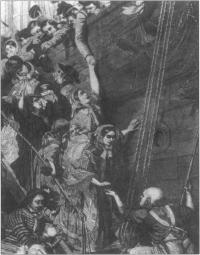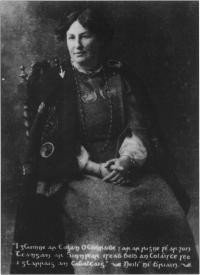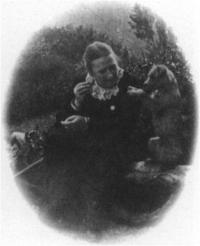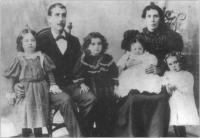‘Tumbling Into the Fight’ Charlotte Grace O’Brien (1845-1909); The Emigrant’s Advocate
Published in 18th-19th Century Social Perspectives, 18th–19th - Century History, 20th Century Social Perspectives, 20th-century / Contemporary History, Features, Issue 4 (Winter 1996), Volume 4
‘Departure from Home’, Harper’s Weekly, 26 June 1859.
(Museum of the City of New York)
Before the Great Famine of 1845-1849, emigration had already established itself as a feature of Irish society. In the five years preceding the Famine, emigration averaged 50,000 per year, but the Famine propelled a huge rise in overall emigration as starving Irish flocked to the ships that represented hope for survival. In 1846, more than 100,000 left, followed by more than 200,000 in 1847. From 1848-1856, the annual average numbered over a quarter of a million people leaving Ireland.
By the time the potato blight abated, emigration had ingrained itself as a permanent characteristic of Irish society; 3.6 million emigrants (not counting those who left for Britain) departed Ireland between 1856 and 1921. The majority of that 3.6 million were female. For every eight Irishmen who left between 1871 and 1951, ten Irishwomen emigrated. Eighty-nine percent of those women were single and younger than twenty-four. The pressing fact of emigration, especially the emigration of young, single women, saddened many commentators, was ignored by even more, but it goaded still others into action. One such person was Charlotte Grace O’Brien, an unlikely activist who devoted her life to aiding emigrating Irishwomen; a poet and author whose writings provide a lens through which to view the story of the thousands who emigrated.
Early years
Charlotte Grace O’Brien was born 23 November 1845 in Cahirmoyle, County Limerick, near the River Shannon and the Clare border. She was the daughter of William Smith O’Brien, an O’Connellite MP who had supported repeal of the Union, and who took part in the abortive rising of 1848, for which he was originally sentenced to death. When his death sentence was commuted, he was exiled to Tasmania, at which time Charlotte was nine years old. Smith O’Brien was allowed to return to Ireland in 1856. Charlotte’s mother died when Charlotte was sixteen, and her father followed three years later. The nineteen-year-old Charlotte went to live with her brother, Edward, and his family, where her sister-in-law, Mary, became her dearest friend and the children became like her own. Following Mary’s death in 1868, Charlotte remained with the family to raise the three children, then aged four, three and two years.
Meanwhile, she began to find her voice as a writer. Although her first publication was Dominick’s Trials: An Irish Story (1870), O’Brien’s 1878 novel about the Fenians, Light and Shade, was more widely known. That novel was eventually joined by poems and a play, as well as Charlotte’s children stories and other contributions to periodicals like The Nation, United Ireland, Limerick Field Club Journal, Dublin University Review and the Irish Monthly.
A hereditary hearing impairment plagued the O’Brien family, especially afflicting one brother who was entirely deaf and mute. as well as Charlotte herself. By 1879, Charlotte, who had been hard of hearing since childhood, had become entirely deaf. Her loss of hearing was accompanied one year later by the loss of her role as a needed child-minder; her brother, Edward, remarried in 1880, which meant that Charlotte was on her own. Her nephew, Stephen Gwynn, published a memoir of her in 1909, in which he notes the turning point that 1880 marked in Charlotte’s life: ‘Now at the age of thirty-four, she had to shape her own life’. Not only did she shape her own life, she dedicated it to helping other Irishwomen shape theirs.
Her first passion was archaeology, but the Land War had captured her attentions by 1881, and revealed her leanings toward the public sphere, as well as her strong feelings of community responsibility. In a letter that she wrote on 17 February 1881, she declares:
My feelings about all this matter [the Land War] are very strong, and I have always held that if one could clearly see one’s way in a great political question, it is not right to hold back. Now the men will probably be imprisoned, it may be all the more necessary the women should come forward.

Charlotte Grace O’Brien in Celtic costume.
‘The play began in earnest’
As it transpired, it was emigration rather than the Land War that drew O’Brien herself forward, but she attacked that problem with the same indignation and drive. Years later O’Brien wrote that she first became involved thanks to two unexceptional actions: she read a book and she paid a visit. The book was J.F. McGuire’s The Irish in America, and of it she declares, ‘I was deeply impressed by his account of the ships, and it took hold of my mind, that was to be my work’. The visit was to Queenstown, embarkation point for many emigrants. In March 1881, she toured the emigrant ship the Germanic, which made real and immediate the passages of McGuire’s book:
The ship happened to be the Germanic (White Star line), not a bit worse, I am sure than any other ship, but I was not prepared for the way I saw all sexes and ages huddled together, etc., etc.. Well, I got into the fight; tumbled into it, I may say.
Her first role was that of lobbyist, and she fought successfully to get a Catholic priest aboard the emigrant ship to help ease the passage, at least spiritually. That achievement captured even more public attention by virtue of the fact that O’Brien herself was Protestant, although she did convert to Catholicism later in life. Next, she turned her attention to corporal needs. O’Brien witnessed the arrival of scores of prospective emigrant women to Queenstown, a scene of
perfect pandemonium, poor creatures from the wilds of Kerry or Connaught emerging like cattle from the crowded carriages, sick with hunger or fatigue, stupefied with grief; and then the mob of lodging house runners seizing them, dragging them this way and that, with noisy exhortations.
In response, she established and ran a 105-bed lodging house in Queenstown that sheltered emigrant girls and women awaiting departure. In 1882, she reported to an American interviewer that about 3,000 lodgers stayed with her each year. While administering the lodging house, O’Brien also policed the ships for which her lodgers were destined, and her later account reveals how conscientiously she regarded her work:
I realised I could do nothing unless I seized the ropes into my own hands… I took a large house in Queenstown, and had myself registered as an ordinary lodging house keeper, licensed for 105 lodgers, and then the play began in earnest… I visited the ships along with a medical officer day after day, often beginning at six o’clock in the morning and going through three or four ships.

Charlotte was very fond of dogs: her deafness rendered her immune to their yapping.
The ocean passage
Those visits convinced O’Brien to cross the ocean herself in order to gain insight into what passage was like for the women passing through her lodging house doors. In 1882, she travelled from Liverpool to Queenstown, a journey of about twenty-four hours, in the steerage berths that carried most Irish emigrants, and of that journey, she reports:
There were four horses berthed among us. It appears it is legal to berth up to ten… It was all awfully dirty and disgusting and the food bad enough, but on the other hand, the people were so friendly, so good to one another, so cheery, I was happy enough.
Although O’Brien made her transatlantic voyages as a non-steerage passenger, she used the journeys to investigate shipboard conditions, and her findings prompted her to lobby for the reform and enforcement of health and safety standards. She recounts her transatlantic voyages and her consequent actions in the following 1882 interview:
I think we have gained several points. One, that single men are almost always berthed, as the English law originally intended, in compartments bulkheaded away from the other sections. The single women are, as a rule, berthed in compartments entirely by themselves, but in some cases the enclosed berths open into the same compartment into which those of the married people open… I should like to see them [ships] provide the bedding and utensils that constitute a steerage outfit… Nobody ever thought of such a thing being done or dreamed of the provision of towels and bowls, to enable steerage folks to wash.
‘New York was to be my next point’
That same interview reveals how O’Brien’s work next progressed to the far side of the Atlantic, along with many of her Queenstown lodgers. ‘Having been at the work more than a year,’ she recalled, ‘I saw clearly that no permanent good could be done in Ireland; and that New York was to be my next point’. In a later account, O’Brien remembers her first visit to the New York tenements in 1882:
When I arrived, instead of going to a hotel or fashionable boarding house, I took a room in a tenement house in Washington Street. I spent some time there with a porter, a longshoreman and their wives. A month spent in New York gave me a full insight into the lives of the Irish emigrants and the fate of the innumerable unprotected girls who were swarming through my own hands in Queenstown.
To a New York interviewer in 1882, she gave an even more striking account of her impressions:
I have not seen one child that in Ireland we would call perfectly healthy… As to your tenement house system, it seems to me to be as miserable a system as it is possible to conceive. I did not happen to visit a single family that had not lost most of the children it had ever had. One does not wonder when one sees the sleeping rooms, with their poisonous atmosphere, all opening into one common apartment. But on the other hand, I have seen people who at home in Ireland were living in cabins at the road-sides along with pigs…living now in real comfort, having nice drawingrooms and everything neat and clean, in tenement houses. I have here a picture of a girl that grew up in a cabin by my father’s gate—the whole family in one apartment. See, she is better dressed than I am. She has a nice home, with lace curtains and pretty and comfortable apartments, and has the manners of a lady. I went, however, into one of those houses across the street, where I saw a score of almost naked children, and every evil of miserable life in Ireland intensified.
To combat some of the miserable conditions that O’Brien observed in New York, she got in contact with Catholic church authorities, particularly Archbishop Ireland, and in 1883 oversaw the establishment of the Our Lady of the Rosary mission, dedicated to immigrant aid. The mission was able to continue the advocacy work of Charlotte Grace O’Brien, even when O’Brien’s failing health curtailed her own immediate involvement.

The family of Daniel and Bridget Lucy Taafe, c.1900.
Bridget left rural County Cork on her own and in the United States raised a family accustomed to living standards the her life as a women in rural Cork could probably not have offered.(Courtesy of Mr and Ms Francis O’Conner)
Opposition
Reaction to emigrant-aid work was not uniformly positive. Some contemporary opinion viewed emigration as a social evil to be battled rather than facilitated. In January 1883 in the Boston Pilot, John Boyle O’Reilly, Drogheda emigrant and exiled nationalist, wrote,
let the odium for their [immigrants’] condition fall on the shoulders of the English Government… Even if our poor unhappy ones died on the wharves here, I for one would say—’let them die’, and let their death protest against the merciless hand that drives them out of their own land, which is rotting for want of human labour.
O’Brien recognised attitudes like O’Reilly’s, and even lamented that the prevalence of emigration detracted from problems at home like land reform, but she also recognised that the trend of emigration was affecting the lives of thousands of departing Irish, and that it held scant regard for her personal opinions on the subject. She answered O’Reilly later in the same year:
But I cannot close my eyes to the fact that a large part of Ireland is in deep distress; that starvation is, in parts, imminent, that the steamship companies have lowered their fares, and that in America there is fair prosperity. That these circumstances combined will produce a heavy immigration next year, I look on as certain. No declamation will prevent it. Apart entirely from the Government emigration, a large number, probably not less than sixty or seventy thousand people, will leave the shores of Ireland next year; of these the largest proportion will go to the United States.
Women helping each other
Neither condemnation nor celebration, but a humanitarian determination to make the best of the inevitable, and to help others to do the same, characterised Charlotte Grace O’Brien’s career in emigration, an attitude shared by many of the emigrants themselves. Women helping each other occurred along every step of the emigration process, from Charlotte Grace O’Brien’s philanthropic efforts, to young servants who sent passage money to sisters, cousins or neighbours, to the writers who published appeals for aid in American newspapers and magazines that catered to Irish immigrant communities. Any balanced understanding of Irishwomen’s emigration must ultimately include the entwined senses of tragedy, survival and community that pervade emigration’s story, and must remember those, like Charlotte Grace O’Brien and the thousands of young women whose Atlantic passage she eased, who shaped and lived the historical phenomenon of emigration.
Chandra Miller is a postgraduate student of Irish Studies at Harvard University.
Further reading:
S. Gwynn, Charlotte Grace O’Brien: Selections from her Writings and Correspondence. with a Memoir by Stephen Gwynn (Dublin 1909).
R.E. Kennedy Jr., The Irish: Emigration, Marriage and Fertility (London 1973).
K.A. Miller, Emigrants and Exiles: Ireland and the Irish Exodus to North America (Oxford 1985).
J.A. Nolan, Ourselves Alone: Women’s Emigration from Ireland 1885-1920 (Kentucky 1989).
















